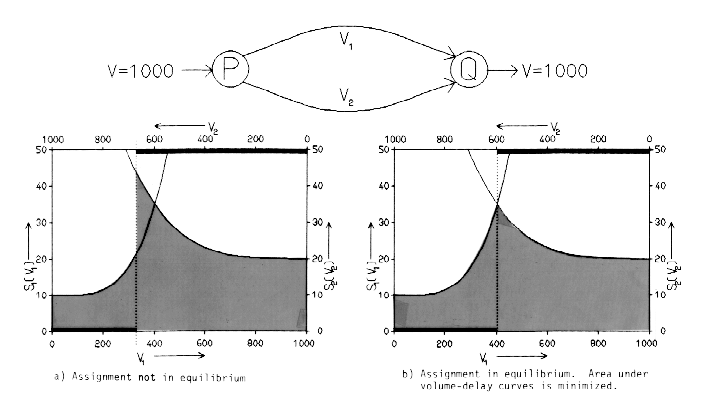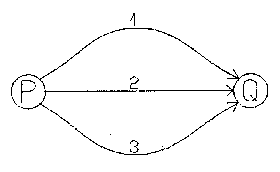
Although the linear approximation algorithm for obtaining the solution of the equilibrium traffic assignment problem is known since 1974 and it has been implemented in several codes (EMME/2, as well as the UROAD module of UTPS, among others), there are still other algorithms used to obtain solution to this problem. Some of the more popular are incremental assignment, capacity restraint and the successive average method. The purpose of this note is to show that the results obtained with the latter methods only approximate the solution of the equilibrium traffic assignment problem.
The behavioral assumption of the equilibrium traffic assignment problem is that each user chooses the route that he perceives the best; if there is a shorter route than the one that he is using, he will choose it. This results in flows that satisfy Wardrop's "user optimal" principle, that no user can improve his travel time by changing routes. The consequence is that the equilibrium traffic assignment corresponds to a set of flows such that all paths used between an origin/destination pair are of equal time. We examine next the results produced for a simple example by the linear approximation method, incremental assignment, capacity restraint and the successive average method.
The solution to the equilibrium traffic assignment problem is equivalent to solving a problem where the area under the volume delay curves is minimized. This can be seen intuitively from the little example below.

The linear approximation method has the advantage that at each cycle (iteration), the total area under the volume-delay curves decreases and a measure of the difference between the current flows and the equilibrium flows can easily be estimated. It has the following general steps:
Initial solution ![]() is obtained by all-or-nothing assignment of
demand g on shortest paths computed with arc costs
is obtained by all-or-nothing assignment of
demand g on shortest paths computed with arc costs ![]() :=s(0), i:=0.
:=s(0), i:=0.
| | >
The example considered consists of three links with the travel time functions shown below. The demand is 1000 trips from P to Q.

![]()
![]()
![]()
The results obtained after the first nine iterations of the linear approximation method, as well as the optimal solution, where all paths used are of equal length are given in the table below.
| Iteration i | | | | | | | F( | |
| 0 | 10.00 | 20.00 | 25.00 | 1000 | 0 | 0 | 197500 | 1.00000 |
| 1 | 947.50 | 20.00 | 25.00 | 403 | 597 | 0 | 19740 | 0.59654 |
| 2 | 34.84 | 34.84 | 25.00 | 338 | 500 | 161 | 18999 | 0.16113 |
| 3 | 22.30 | 27.35 | 25.31 | 362 | 483 | 155 | 18945 | 0.03555 |
| 4 | 26.09 | 26.36 | 25.27 | 355 | 473 | 173 | 18936 | 0.02040 |
| 5 | 24.82 | 25.86 | 25.41 | 359 | 469 | 171 | 18934 | 0.00719 |
| 6 | 25.61 | 25.69 | 25.40 | 357 | 467 | 176 | 18933 | 0.00536 |
| 7 | 25.28 | 25.57 | 25.44 | 359 | 466 | 175 | 18933 | 0.00200 |
| 8 | 25.50 | 25.52 | 25.44 | 358 | 465 | 177 | 18933 | 0.00156 |
| 9 | 25.40 | 25.49 | 25.45 | 358 | 465 | 177 | 18933 | 0.00059 |
| Opt.Sol. | 25.46 | 25.46 | 25.46 | 358 | 465 | 177 | 18933 | 0.00000 |
The figures under the column indicated F(v) give the area under the volume-delay curves which is minimized where the flows are so-called "equilibrium" flows and all the paths used are of equal length.
The incremental method proceeds through the following general steps:
Define number of increments N, ![]() :=0; i:=0.
:=0; i:=0.
i:=i+1; ![]() :=s(
:=s( ![]() ).
).
![]() : all-or-nothing assignment of demand g/N on shortest path computed
with arc costs
: all-or-nothing assignment of demand g/N on shortest path computed
with arc costs ![]() .
.
![]() :=
:= ![]() +
+ ![]() .
.
If i<N return to step 1,
otherwise ![]() :=
:= ![]() ,
, ![]() :=s(
:=s( ![]() ) and STOP.
) and STOP.
The results obtained with the incremental assignment method where N is chosen to be 10 are given in the table below.
| Iteration i | | | | | | | F( |
| 1 | 10.00 | 20.00 | 25.00 | 100 | 0 | 0 | 1002 |
| 2 | 10.09 | 20.00 | 25.00 | 200 | 0 | 0 | 2060 |
| 3 | 11.50 | 20.00 | 25.00 | 300 | 0 | 0 | 3456 |
| 4 | 17.59 | 20.00 | 25.00 | 400 | 0 | 0 | 5920 |
| 5 | 34.00 | 20.00 | 25.00 | 400 | 100 | 0 | 7920 |
| 6 | 34.00 | 20.01 | 25.00 | 400 | 200 | 0 | 9928 |
| 7 | 34.00 | 20.19 | 25.00 | 400 | 300 | 0 | 11977 |
| 8 | 34.00 | 20.95 | 25.00 | 400 | 400 | 0 | 14160 |
| 9 | 34.00 | 23.00 | 25.00 | 400 | 500 | 0 | 16652 |
| 10 | 34.00 | 27.32 | 25.00 | 400 | 500 | 100 | 19153 |
| Solution | 34.00 | 27.32 | 25.05 | 400 | 500 | 100 | 19153 |
It is easy to see that the flows resemble those obtained with the linear approximation method but the times are not equal on all the used links. Since the method is heuristic, there is no reason to anticipate that the flows will satisfy strictly the equilibrium conditions; the fact that the times may be quite different on the paths used makes it impossible to use the travel times for cost benefit analyses.
The capacity restraint method is probably one of the first heuristic methods used for the emulation of equilibrium flows. It proceeds through the following general steps:
Define number of iterations N.
Initial solution ![]() is obtained by
all-or-nothing assignment
on shortest paths computed with arc costs
is obtained by
all-or-nothing assignment
on shortest paths computed with arc costs
![]() :=s(0); i:=0.
:=s(0); i:=0.
i:=i+1; ![]() :=0.75
:=0.75 ![]() +0.25 s(
+0.25 s( ![]() ).
).
![]() : all-or-nothing assignment on shortest path computed with arc costs
: all-or-nothing assignment on shortest path computed with arc costs ![]() .
.
If i<N return to step 1,
otherwise ![]() :=
:= ![]() ,
, ![]() :=s(
:=s( ![]() ) and STOP.
) and STOP.
As can be seen in the table of results below, this method produces flows which are quite different than the equilibrium flows.
| Iterationi | | | | | | | F( |
| 0 | 10.00 | 20.00 | 25.00 | 1000 | 0 | 0 | - |
| 1 | 244.38 | 20.00 | 25.00 | 0 | 1000 | 0 | - |
| 2 | 185.79 | 49.30 | 25.00 | 0 | 0 | 1000 | - |
| 3 | 141.84 | 41.98 | 140.74 | 0 | 1000 | 0 | - |
| 4 | 108.88 | 65.79 | 111.81 | 0 | 1000 | 0 | - |
| 5 | 84.16 | 83.64 | 90.11 | 0 | 1000 | 0 | - |
| 6 | 65.62 | 97.03 | 73.83 | 1000 | 0 | 0 | - |
| 7 | 286.09 | 77.77 | 61.62 | 0 | 0 | 1000 | - |
| 8 | 217.07 | 63.33 | 168.21 | 0 | 1000 | 0 | - |
| 9 | 165.30 | 81.80 | 132.41 | 0 | 1000 | 0 | - |
| 10 | 126.48 | 95.65 | 105.56 | 0 | 1000 | 0 | - |
| Solutions | | | | | | | |
| for N=9 | 13.66 | 27.32 | 26.81 | 250 | 500 | 250 | 19756 |
| for N=10 | 10.00 | 57.08 | 26.81 | 0 | 750 | 250 | 26902 |
The last method which we will look at is the successive average method which is known to be a convergent method, but the convergence is very slow and there is no reasonable stopping criterion, other than an arbitrary number of iterations. The method resembles the linear approximation method, except that the step size, lambda, is arbitrarily fixed to yield a solution in which each of the all-or-nothing flows yi have the same weight. The general steps of the method are:
Define number of iterations N. Initial solution ![]() is obtained by
all-or-nothing assignment of demand g on shortest paths computed with
arc costs
is obtained by
all-or-nothing assignment of demand g on shortest paths computed with
arc costs ![]() := s(0), i:=0.
:= s(0), i:=0.
<N return to step 1,
otherwise
Several iterations on this method yields the following results.
| Iteration i | | | | | | | F( | |
| 0 | 10.00 | 20.00 | 25.00 | 1000 | 0 | 0 | 197500 | |
| 1 | 947.50 | 20.00 | 25.00 | 500 | 500 | 0 | 21592 | 0.50000 |
| 2 | 68.59 | 27.32 | 25.00 | 333 | 333 | 333 | 19582 | 0.33333 |
| 3 | 21.57 | 21.45 | 30.72 | 250 | 500 | 250 | 19756 | 0.25000 |
| 4 | 13.66 | 27.32 | 26.81 | 400 | 400 | 200 | 19190 | 0.20000 |
| 5 | 34.00 | 23.00 | 25.74 | 333 | 500 | 167 | 19016 | 0.16667 |
| 6 | 21.57 | 27.32 | 25.36 | 429 | 429 | 143 | 19484 | 0.14286 |
| 7 | 41.63 | 23.95 | 25.19 | 375 | 500 | 125 | 19001 | 0.12500 |
| 8 | 28.54 | 27.32 | 25.11 | 333 | 444 | 222 | 19006 | 0.11111 |
| 9 | 21.57 | 24.57 | 26.13 | 400 | 400 | 200 | 19190 | 0.10000 |
| Solution | 34.00 | 23.00 | 25.74 | 400 | 400 | 200 | 19190 |
It is easy to see that the method has a tendency to "oscillate" and after nine iterations the flows resemble the equilibrium flows but the times are quite different on the used links.
The conclusion to be drawn from this little exercise is that having many algorithms for the equilibrium traffic assignment is not a blessing. It suffices to have one that is robust and which has good theoretical foundation, good empirical convergence and a good stopping criterion.